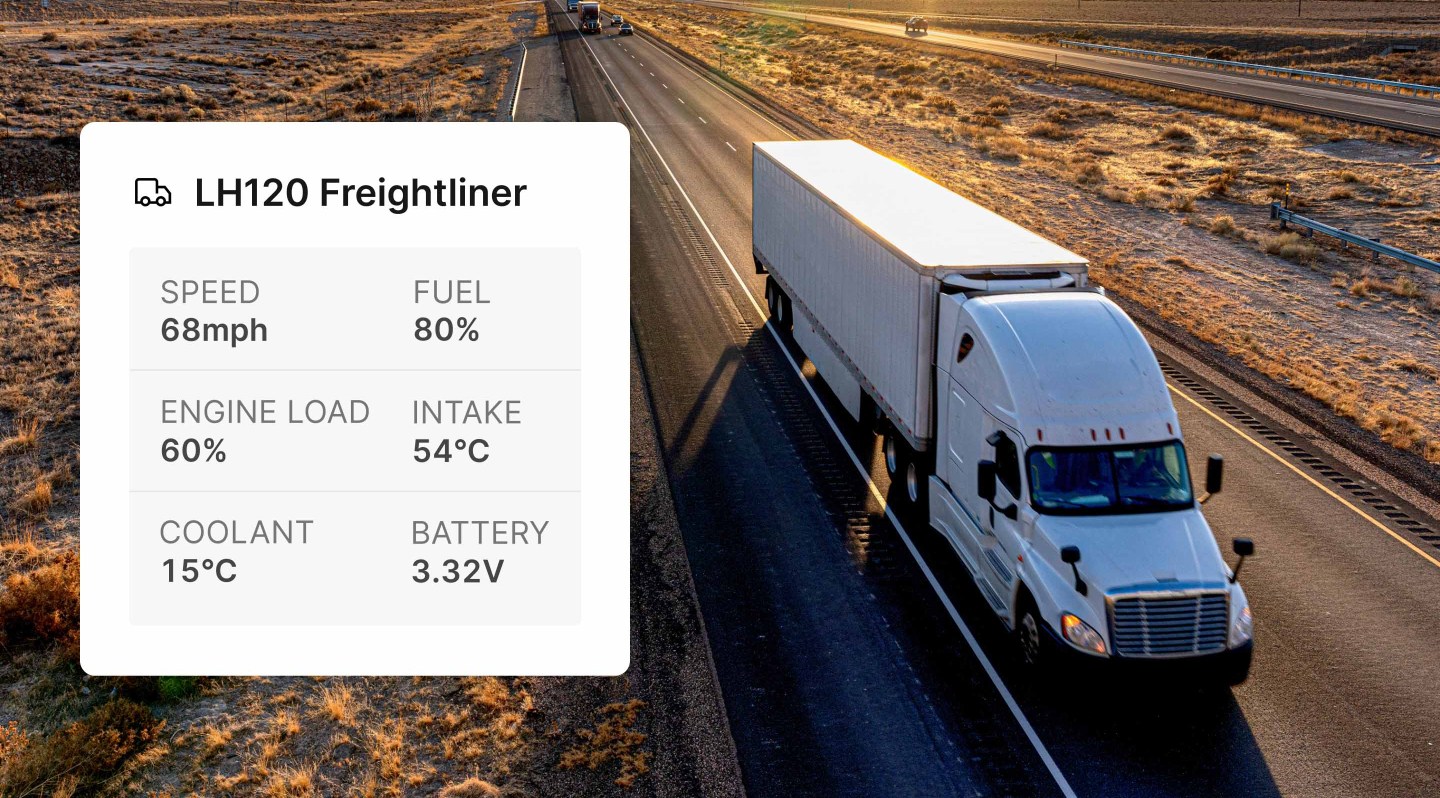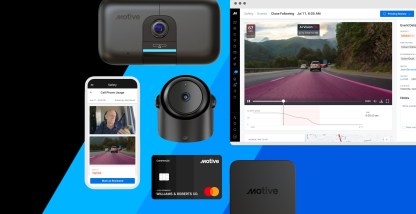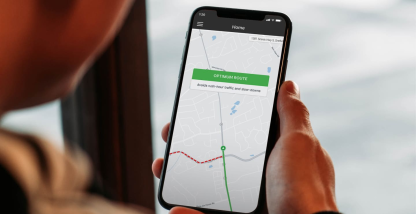Fleet telematics empowers managers with valuable real-time insights enabling data-driven decision making. Vehicle tracking, performance analysis, driver behavior monitoring, compliance management, cost optimization, and route planning can all benefit from fleet telematics. See how leveraging vehicle telematics enables managers to enhance operational efficiency, reduce costs, improve safety, and make informed decisions to drive their fleets forward.
Telematics transmits information remotely over long distances, making it critical to fleet operations for many industries. Whether in oil and gas, construction, food and beverage, agriculture, logistics, or another industry, being able to access data using a combination of GPS technology, sensors, and onboard diagnostics codes increases operational visibility.
Real-time data transfer improves communications, efficiency, and customer service by providing transparency into vehicle location, driver behavior, vehicle activity, and asset diagnostics. Fleet telematics systems let fleet owners and managers manage their assets remotely using software located at a dispatch center or in the fleet manager’s office.
How do fleet telematics solutions work?
Fleets install telematics devices into vehicles to transmit data via telecommunications networks to the fleet management software to process information about vehicle location and usage, fuel consumption, maintenance issues, and more. Fleet managers can also gain insights into driver behaviors and asset idle time to identify at-risk drivers, improve safety, and cut costs.
Commercial telematics devices generally connect to the vehicle’s onboard systems, such as the engine, sensors, and GPS receiver. The device collects data from these sources using sensors, connectors, and interfaces — and often includes a modem for communication and internal storage for data logging.
The collected data is then packaged and transmitted (using cellular networks, satellite, Wi-Fi, or Bluetooth), to a central server or cloud-based fleet management platform. Once it’s received, it’s stored for further processing and analysis. In this central hub, managers and others can access the data for analysis, visualization, and reporting. From here, fleet managers are empowered to make data-driven decisions and take appropriate actions.
Fleet telematics solutions for improved decisions
Telematics allows fleet managers to gather and analyze real-time data from vehicles and drivers. This data can provide valuable insights and inform decision making across various aspects of fleet management by helping to:
- Analyze driver behavior and safety
- Optimize route planning and dispatching
- Support continuous improvement
- Identity preventive maintenance opportunities
- Simplify compliance
Let’s look at each of these points a little closer.
Analyze driver behavior and safety
Telematics devices collect data on driver behaviors including speeding, harsh braking, and excessive idling. Monitoring driver behavior, along with vehicle and equipment performance using data can help identify at-risk drivers and training opportunities. A fleet can build out its new driver onboarding around known issues and tailor its ongoing safety program to coach drivers in a continuously relevant way by analyzing telematics data.
Additionally, the real-time GPS fleet telematics data can be immediately helpful in the event of an incident with the ability to direct emergency assistance where needed.
Optimize route planning and dispatching
Data-driven insights not only help improve driver safety and reduce accidents but also help to lower fuel consumption and optimize vehicle utilization. With real-time telematics data available, managers can monitor traffic conditions and congestion to minimize travel time and enhance operational efficiency.
The at-the-moment insight into routes in combination with historical data can lead to reduced mileage, fuel consumption, and asset wear and tear as managers can optimize route planning. At the same time, the centralization of data reduces the need for drivers to check in with fleet managers. Automating much of the process lets drivers focus on their most important work and increases manager resources.
This optimized route dispatch can also enhance customer service. With visibility into where assets are and estimated arrival times, companies can communicate more effectively with customers to manage expectations.
Support continuous improvement
Collecting telematics data gives the business a longer-term view of operations. By analyzing data for trends and patterns, managers can identify opportunities for improvements.
For example, based on performance analysis of the data, drivers who are unnecessarily hard on vehicles might be identified and given targeted training. Or leverage telematics data to monitor fuel usage and optimize fuel efficiency. With the ability to analyze specific factors, managers can dig into the data to determine whether driving habits, idling time, or route selection are negatively impacting fuel consumption. This could lead to substantial fuel cost savings and lower emissions.
Identify predictive maintenance opportunities
Collecting data on various vehicle metrics can help fleets to schedule predictive maintenance and also identify potential issues before they lead to costly downtime. Fleet managers can enjoy a consolidated view of telematics data about fuel consumption or engine diagnostics along with maintenance schedules to identify patterns, detect potential issues, and make data-driven decisions about vehicle maintenance, repairs, and replacements.
Simplify compliance
The data collected by telematics systems can also assist with regulatory requirements and industry standard compliance. Instead of having to rely on manual reporting and hand-written logs, fleet managers can immediately collect data on driver hours of service or vehicle inspections to make decisions that ensure compliance, minimize violations, and avoid penalties.
Get started with telematics for fleet management
The amount of data available from telematics devices may feel overwhelming. Still, you can incorporate telematics into your fleet management in four straightforward steps.
1. Find a fleet telematics solution
You’ll find many telematics provider options available. Start by evaluating different telematics solutions based on criteria such as:
- Fleet size
- Vehicle types
- Data you want to collect
- Specific goals (e.g., fuel efficiency, driver safety, maintenance optimization)
- Provider’s track record and industry experience
- Customer reviews
- Range of services offered
- Ease of installation
- Solution scalability
- Compatibility with existing fleet management systems
- Customer support provided
- Price and return on investment
- Training and technical support
2. Set clear objectives and KPIs
Take full advantage of the abundance of data from telematics systems by aligning relevant key performance indicators (KPIs) with your business objectives. Then, use the collected data to measure performance and assess success.
For example, fleet managers might set KPIs around fuel efficiency by monitoring fuel usage data within the fleet. Examining fuel consumption, idling time, and driver behavior data can help identify areas for improvement. Managers might use the data to implement fuel-saving initiatives and monitor the impact of driver training programs or vehicle maintenance on fuel efficiency.
Driver safety score KPIs can also be supported by telematics device data. Gathering data on speeding, harsh braking, rapid acceleration, and other unsafe driving practices, fleet managers can determine how well drivers follow safe driving practices. Tracking performance over time helps identify high-risk drivers who could benefit from targeted training programs.
Telematics data could provide a more accurate picture also of vehicle utilization rate, maintenance cost per mile, average delivery time, compliance with regulatory requirements, customer satisfaction ratings, and more.
3. Monitor fleet telematics in real time and set alerts
The immediacy of the data is a main benefit of telematics. Tracking vehicle locations and statuses in real time saves drivers from having to check in with fleet managers. Meanwhile, managers can set up alerts to notify them of issues such as hard braking, speeding, potential HOS violations, critical maintenance concerns found in vehicle inspections, and much more. With the tools to monitor activity and understand the data in a larger context, managers can make more data-driven decisions in critical situations (or help avoid them altogether).
GPS telematics data can also work with geofencing to establish virtual boundaries. This can help managers track vehicle entry and exit time in designated areas or prevent unauthorized vehicle usage.
4. Gather and analyze fleet telematics data
Managers can access a wealth of information from telematics systems. This can include:
- GPS location
- Vehicle diagnostics
- Speed, acceleration, and deceleration
- Idling
- Fuel consumption
- Maintenance and service
- Driver behavior
- Geofencing
- Hours of service
- Environmental
Leverage the full power of this data by gathering and analyzing it. For instance, managers might look at mileage and engine hours to determine preventive maintenance needs. Or analyze driver behavior data to identify risky driving practices and improve overall safety.
Integrating telematics data with other business systems can further streamline operations, automate processes, and improve the bottom line. By consolidating meaningful data in easily accessible dashboards, with the benefit of reporting and visualization tools, regular performance monitoring can become par for the course for your business.
A telematics solution designed to improve decisions
Fleet telematics devices integrated with fleet management software can benefit driver safety, optimize route planning, improve customer satisfaction, drive continuous improvement, streamline maintenance, and simplify compliance.
Motive’s comprehensive fleet management solution enables your business to harness the power of fleet telematics for improved performance through ongoing monitoring and adaptation.
Telematics can benefit your fleet and business. Request a free demo of our all-in-one fleet management and telematics solution and discover the benefits firsthand.










